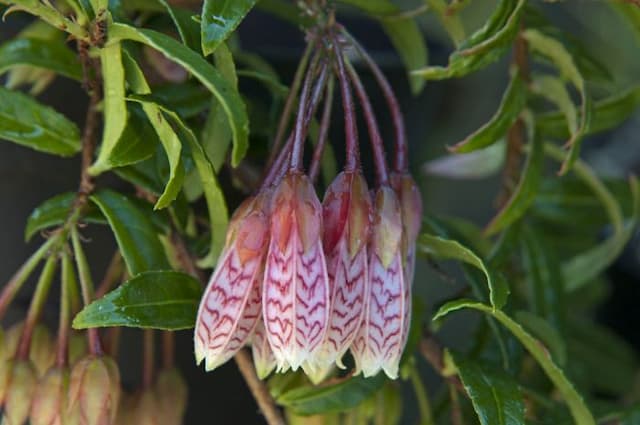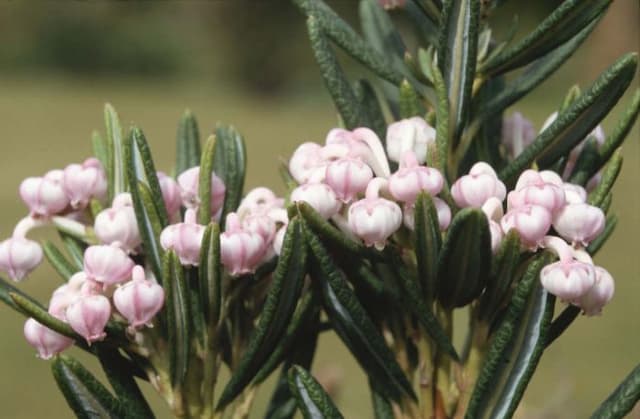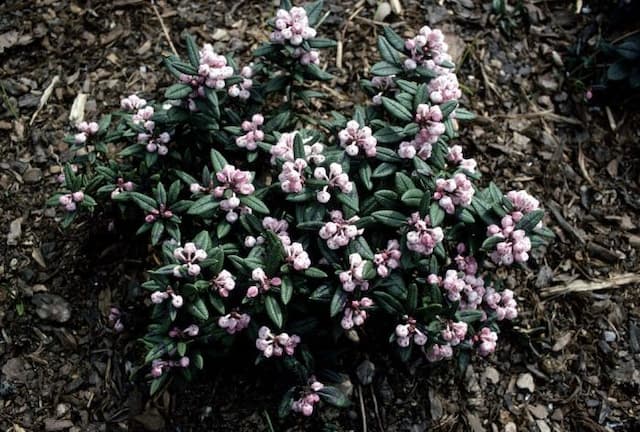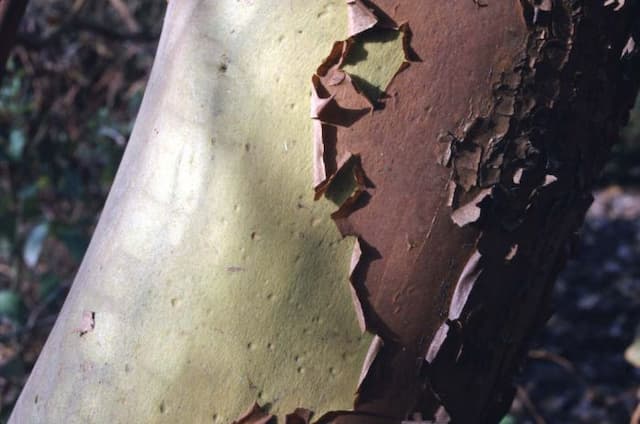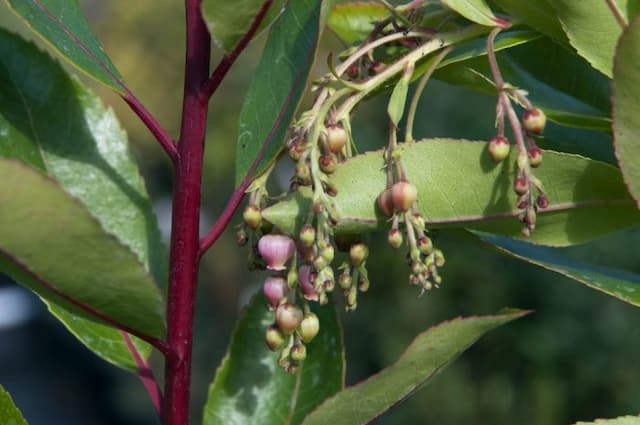White Heath Erica carnea f. alba 'Snow Queen'

ABOUT
'Snow Queen' is an evergreen shrub known for its stunning visual appeal throughout the year. It has needle-like foliage that remains a deep, rich green throughout the seasons, providing an excellent background for its profusion of white flowers. These blooms emerge in small, urn-shaped clusters, resembling tiny bells and offering a splash of brightness against the dark foliage. The flowers tend to cover the plant from late winter to early spring, enlivening the garden when few other plants are in bloom. The contrast between the white flowers and dark green leaves makes the 'Snow Queen' an attractive feature in garden settings, rockeries, or as ground cover. This particular variety is appreciated for its hardiness and the splash of color it provides during the colder months.
About this plant
 Names
NamesFamily
Ericaceae.
Synonyms
White Alpine Heath, Snow Queen Heath, Winter Heath.
Common names
Erica carnea f. alba 'Snow Queen'.
 Toxicity
ToxicityTo humans
Winter heath is not commonly known to be toxic to humans. There are no well-documented cases of poisoning from ingesting this plant. Therefore, no specific symptoms of poisoning are associated with it. Nevertheless, it is generally advised that one should not eat plants that are not specifically grown for consumption, as they may cause digestive discomfort or allergic reactions in some individuals.
To pets
Winter heath is not widely recognized as a toxic plant to pets. There are no prevalent reports of toxicity in animals such as dogs and cats that would suggest severe symptoms or consequences from ingesting the plant. However, as with humans, non-food plants can sometimes cause gastrointestinal upset or allergic reactions in pets, so it is still a good practice to prevent pets from eating ornamental plants.
 Characteristics
CharacteristicsLife cycle
Perennials
Foliage type
Evergreen
Color of leaves
Green
Flower color
White
Height
1 foot (30 cm)
Spread
1-2 feet (30-60 cm)
Plant type
Shrub
Hardiness zones
5
Native area
Europe
Benefits
 General Benefits
General Benefits- Decorative Appeal: 'Snow Queen' Heather adds visual interest to gardens with its vibrant white flowers that bloom in late winter or early spring.
- Low Maintenance: This plant is well-known for being easy to care for, requiring minimal upkeep once established in the right conditions.
- Drought Tolerance: Once established, 'Snow Queen' Heather is relatively drought-resistant, making it suitable for xeriscaping or dry gardens.
- Soil Versatility: It can thrive in a range of soil types, including those that are acidic or poor in nutrients, though it prefers well-drained conditions.
- Wildlife Attraction: The flowers provide a valuable source of nectar for bees and other pollinators, especially when few other plants are in bloom.
- Evergreen Foliage: 'Snow Queen' Heather has evergreen foliage, which provides year-round color and texture to the garden landscape.
- Ground Cover: Its dense growth habit makes it an excellent ground cover, helping to suppress weeds and stabilize soil on slopes or banks.
- Winter Interest: The plant maintains its visual appeal even in the coldest months, providing a welcome splash of color when most other plants have died back or are dormant.
- Border Planting: Its compact size makes it ideal for use as an edging or border plant in garden designs.
- Containment: Suitable for containers, 'Snow Queen' can add beauty to balconies, terraces, and other small spaces.
 Medical Properties
Medical PropertiesThis plant is not used for medical purposes.
 Air-purifying Qualities
Air-purifying QualitiesThis plant is not specifically known for air purifying qualities.
 Other Uses
Other Uses- Winter Garden Interest: The 'Snow Queen' variety of Winter Heath provides vibrant color and texture to gardens during the dreary winter months when most other plants are dormant.
- Model Landscaping: Due to its small size and low maintenance, it can be used in model train landscapes or other miniature scenes.
- Edging Plants: Winter Heath works well as a natural edge for paths and flower beds due to its compact growth habit.
- Sloped Garden Stabilization: This plant's root system helps stabilize sloping areas in the garden, preventing soil erosion.
- Photography Prop: The plant’s bright white blooms are often used as a backdrop or feature in macro and garden photography.
- Therapeutic Horticulture: Cultivating 'Snow Queen' can be used as a therapeutic activity to promote well-being and relaxation.
- Container Gardening: Due to its size and adaptability, it is an excellent choice for pots and container arrangements.
- Fairy Gardens: Its delicate appearance is apt for creating enchanted fairy garden designs.
- Winter Containers: Adding 'Snow Queen' to winter container displays can bring life to patios and balconies when other plants are not flowering.
- Bonsai Culture: Some enthusiasts use Winter Heath for bonsai due to its small leaves and potential for intricate pruning.
Interesting Facts
 Feng Shui
Feng ShuiThe Winter Heath is not used in Feng Shui practice.
 Zodiac Sign Compitability
Zodiac Sign CompitabilityThe Winter Heath is not used in astrology practice.
 Plant Symbolism
Plant Symbolism- Purity: The pristine white flowers of the 'Snow Queen' variety of Winter Heath (Erica carnea) suggest purity and innocence, much like the unblemished beauty of fresh snow.
- Solitude: Winter Heath thrives in cold winter months, a time often associated with quiet and solitude, symbolizing the ability to flourish in times of reflection and peace.
- Protection: Historically, heaths were thought to have protective qualities, and planting them near one's home was believed to guard against negative forces.
- Survival: As a plant that blooms in harsh conditions, the Winter Heath represents resilience and the power to survive adversity.
 Water
WaterFor the Winter Heath 'Snow Queen', water thoroughly when the top inch of soil feels dry to the touch, typically every one to two weeks, depending on the climate and weather conditions. During hotter, drier months, you may need to water more frequently, ensuring you provide 1 gallon of water per plant each time to saturate the root zone. In cooler, wetter seasons or climates, reduce the frequency to prevent waterlogging, as this plant prefers well-drained soils and can be sensitive to overwatering. It's vital to avoid letting the plant sit in waterlogged soil as it can lead to root rot.
 Light
LightWinter Heath 'Snow Queen' thrives in full sun to partial shade. The ideal spot would provide at least 4 to 6 hours of direct sunlight daily while offering some relief from the intense midday sun in hotter climates. Dappled sunlight or a location with morning sun and afternoon shade can be perfect for this plant, ensuring bright conditions without excessive stress.
 Temperature
TemperatureWinter Heath 'Snow Queen' prefers cool to moderate temperatures and can tolerate a range from 20°F to 70°F, making it quite hardy. Ideally, maintain a temperature around 50°F to 60°F for optimal growth. While it can survive brief periods of colder dips and higher spikes, sustained temperatures outside the preferred range can stress the plant.
 Pruning
PruningPrune Winter Heath 'Snow Queen' annually to maintain its compact shape and encourage new growth. The best time for pruning is immediately after flowering, typically in late spring. Remove spent flower spikes and lightly shape the plant, cutting back into the previous year's growth. Pruning every year can also help prevent the center of the plant from becoming woody and bare.
 Cleaning
CleaningAs needed
 Soil
SoilWinter Heath (Erica carnea f. alba 'Snow Queen') prefers well-drained, acidic soil with a pH range of 4.5 to 5.5. The best soil mix can be prepared by combining peat moss, sand, and loamy soil in equal parts to ensure proper drainage and acidity.
 Repotting
RepottingWinter Heath typically does not need frequent repotting and can thrive in the same pot for several years. Assess the need for repotting every 2 to 3 years and repot if the plant has outgrown its container or the soil has degraded.
 Humidity & Misting
Humidity & MistingWinter Heath enjoys moderate humidity levels. The plant will do well in typical outdoor humidity conditions and does not have special indoor humidity requirements.
 Suitable locations
Suitable locationsIndoor
Place in bright, indirect light and ensure acidic soil for indoor Winter Heath.
Outdoor
Plant in partial shade to full sun with well-drained, acidic soil for outdoor Winter Heath.
Hardiness zone
5-7 USDA
 Life cycle
Life cycleThe life of the 'Snow Queen' Winter Heath begins with seed germination, typically taking place in a well-drained, acidic soil, often during spring or early summer. Seedlings emerge and develop into juvenile plants, establishing a root system and beginning to grow their characteristic needle-like leaves. As the plant matures, it enters the vegetative stage, forming a dense, low-growing evergreen shrub with foliage remaining green throughout the year. In late winter to early spring, the 'Snow Queen' Winter Heath produces profuse white flowers, which attract pollinators to the garden. After pollination, the flowers develop into small seed capsules, containing seeds that, when mature, are dispersed to initiate new life cycles. Once mature, the plant can continue to grow and flower for many years, with some pruning required to maintain its compact shape and encourage bountiful flowering.
 Propogation
PropogationPropogation time
Spring-summer
The most popular method of propagation for the Snow Heath is by semi-hardwood cuttings. This process is typically done in late summer. One would take a cutting of about 2 to 4 inches (5 to 10 cm) long from the current year’s growth, ensuring that there are at least a couple of sets of leaves. The lower leaves are then removed, and the cutting base is dipped in rooting hormone before being placed in a moistened mixture of equal parts peat and perlite. The cuttings need to be kept in a warm and well-lit area but out of direct sunlight, and the medium should be kept consistently moist. Roots usually develop in a few weeks, after which the new plants can eventually be transferred to individual pots and grown on until they are large enough to plant out.
